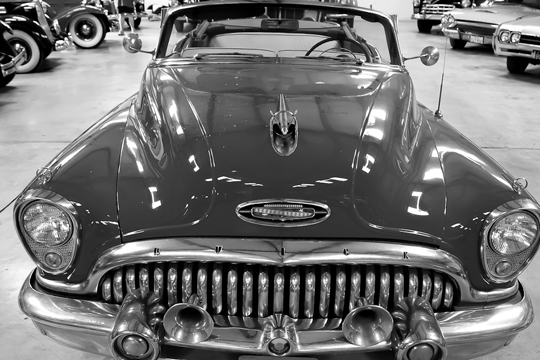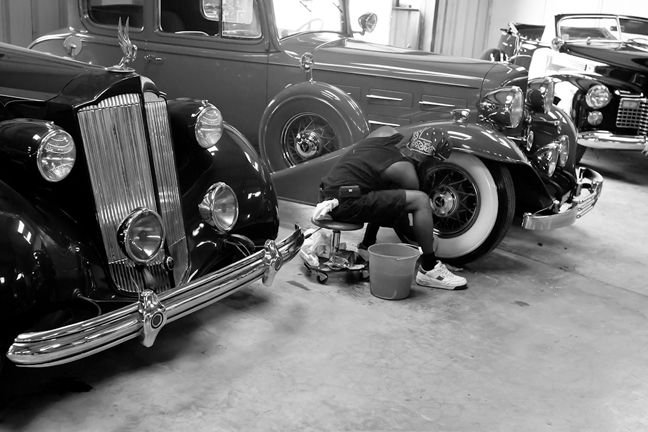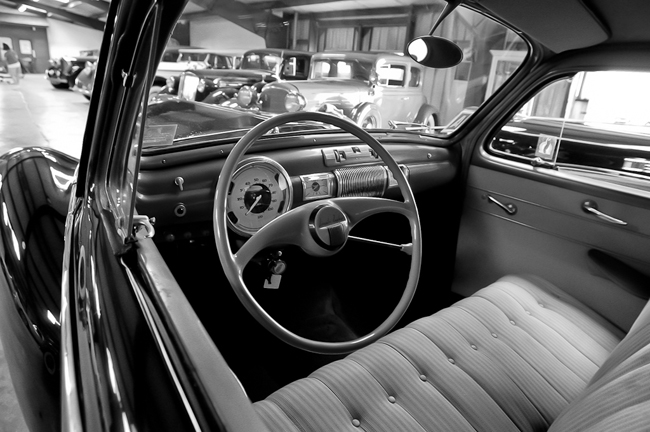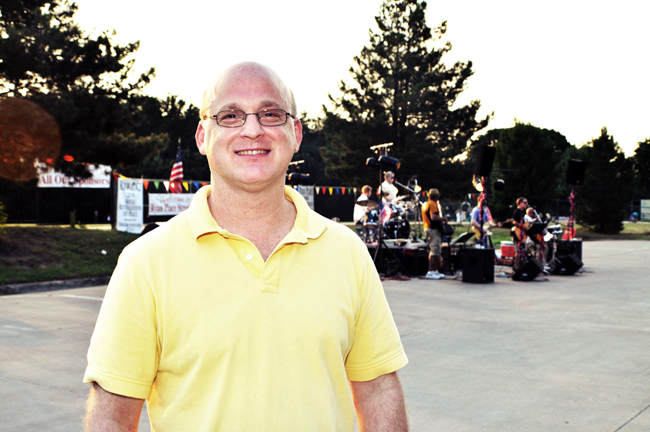It’s been part of the landscape on State Highway 377 for more than 40 years. Each time I drove past the Pate museum and saw the giant cargo plane looming in the distance, it brought up memories of climbing on the tanks as a child or slogging through the mud at a swap meet looking for some part for my 1953 Harley-Davidson. But nothing lasts forever, especially in the Metroplex. On June 5, the cars and many other items at the Pate Museum of Transportation will be auctioned, and other parts of the collection are being moved as well.

The military vehicles that used to cover the grounds are now almost all gone. The C-119 “Flying Boxcar,” the Canadian jet fighter, and the helicopter sit waiting to be picked up by the federal government for transport to their new homes. The big minesweeper boat is more problematic — it will take a great deal of money to move it. But Sharon Pate is most worried about the cars, a collection that began with the 1929 Packard that will be among the auction items on Saturday, on through sports cars, a limousine, and even an infamous taxi. She talks about them like beloved pets.
“When we stopped getting all the people out here, we tried to move the cars to Fort Worth, and we just never got it to work out,” she said. She’s the daughter of the museum’s founder, Aggie Pate, who died in 1988. “So we have to do what’s best for the cars, to keep them from really getting in bad condition. Hopefully people will take these cars and restore them and show them. What we’re doing is hard on the whole family. I’ve sat up many nights and cried. But we’re having to do what’s best for the cars, not what’s best for us.”
Inside the buildings, people are hurriedly preparing for the upcoming auction. Viewing starts Friday (June 4) at 9 a.m. The auction runs from 9 a.m. to 6 p.m. Saturday, resumes at 9 a.m. Sunday, and continues until everything is sold. Roger “Panama Jack” Wekes, an expert detailer brought in for the auction, has been cleaning and polishing the fleet of vintage vehicles, while Donnie Doyle of RM Auctions sorts through mountains of books, photos, model airplanes, and model ships.
 The Pate’s most important pieces, like the airplane and dirigible motors that were donated by the Smithsonian, and some of the literature, will go to other museums. But most of the rest will be auctioned along with the cars. Even a historical chapel on the property, complete with state marker, will go under the gavel. (The buyer will have six months to move the building from the property.)
The Pate’s most important pieces, like the airplane and dirigible motors that were donated by the Smithsonian, and some of the literature, will go to other museums. But most of the rest will be auctioned along with the cars. Even a historical chapel on the property, complete with state marker, will go under the gavel. (The buyer will have six months to move the building from the property.)
“It will give everybody in the area an opportunity to come and get a piece of the Pate Museum and take it home as a keepsake — a car or some books from the library or a piece of memorabilia that has been hanging on the wall,” Doyle said. “If they have $50 or $100, they will be able to take home a piece of the Pate.”
The car collection includes a 1903 Cadillac that once belonged to Amon Carter, a ’62 Checker taxi that Lee Harvey Oswald rode in after allegedly assassinating John F. Kennedy, a ’67 Shelby GT 500 Fastback, a 1935 Aston Martin, a Russian limousine, a DeLorean, and a ’29 Packard (Pate’s first car in the collection).
Sorting through the collection has been bittersweet for the family.
 “It’s been here since I was 14,” said Sharon. “It’s been emotionally draining. It’s like losing my dad all over again, and I just lost my uncle last August. We’re here cleaning stuff out, and you say, ‘I remember when Dad got that,’ and you kind of have the giggles, and then you want to cry.”
“It’s been here since I was 14,” said Sharon. “It’s been emotionally draining. It’s like losing my dad all over again, and I just lost my uncle last August. We’re here cleaning stuff out, and you say, ‘I remember when Dad got that,’ and you kind of have the giggles, and then you want to cry.”
Even more painful have been the comments from the museum’s fans on the internet. Many people, who don’t realize how expensive it is to run a museum like this, have criticized the family for the decline of the collection over the years, assuming it was due to indifference or greed on the part of Aggie Pate’s descendants.
In reality, the Pate Foundation just didn’t have the money to beat back the ravages of time, weather, and vandals. The insurance bill alone, for a museum with a multimillion-dollar car and airplane collection, was crushing.
Pate built the museum for the children and even had a trampoline installed for them to play on, but insurance costs put an end to that as well. With the outdoor military displays (planes, tanks, and artillery on loan from the government) suffering from vandals and weather, the military removed many of them to a safer location.
Admission to the museum was always free, although donations were appreciated. But as the number of vehicles on display diminished, so did the donations.
On Thursday, the Pate will begin charging admission for the first time — $20 to attend the three-day auction, $50 for those who want to bid. Other details and a list of cars to be auctioned are available at www.rmauctions.com.
The Pate family won’t keep any of the cars or any of the profits of the auction. “The cars will be sold,” said Sharon, “and the money will go back to the Pate Foundation. None of us get a drop of it, and we will still be able to make some donations toward other things in Fort Worth.
“When the last Pate car goes through the line, I think that’s when it’s going to hit,” she said. “This was a labor of love for my dad and my uncle.” They met “so many wonderful people over the years,” she said, including those who “donated some great cars.”
Local writer and photographer Steve Watkins can be reached at Steve@storyandphotosby.com.
Less Bunting, More Red Tape
Fort Worth neighborhood leaders are howling over proposed special-events rules.
BY DAN MCGRAW
The parking lot in Ryan Place was packed with people on Saturday night, neighbors sitting on folding chairs, little kids dancing to a classic rock band, wine and beer flowing in the hot summer night.
The event was the neighborhood association’s annual Memorial Street Dance, which Ryan Place has been sponsoring for about 25 years. A few hundred people showed up, and the organizers promoted the positive effects of such neighborhood parties: Neighbors get acquainted, which leads to their watching out for one another, which helps with crime control.
 You might think the city would help neighborhood associations sponsor such events and make it easier to organize everything from holiday picnics to Fourth of July parades to dancing in the streets. But a new ordinance being promoted by the city staff could make it much more difficult to throw even a simple street dance in Fort Worth. Many neighborhood leaders are up in arms over the proposed changes.
You might think the city would help neighborhood associations sponsor such events and make it easier to organize everything from holiday picnics to Fourth of July parades to dancing in the streets. But a new ordinance being promoted by the city staff could make it much more difficult to throw even a simple street dance in Fort Worth. Many neighborhood leaders are up in arms over the proposed changes.
“We feel these restrictive rules will have a definite impact, and it comes down to restricting quality of life in our neighborhoods,” said John Kline, president of the Ryan Place Improvement Association. “We do these things to promote a sense of community. But all this bureaucratic red tape, having to come up with formal security plans and attend meetings, is just making having a simple neighborhood picnic extremely complicated.
“Instead of making it easier, the city seems to be making it harder,” Kline said. “That’s not going to fly in Fort Worth neighborhoods.”
The “Special Events Ordinance” would require organizations in some cases to put down security deposits with the city, pay for a $1 million liability insurance policy, and present security plans to a city-council-appointed calendars committee before permits for local events would be issued — and there’s no word yet on how much those permits would cost. In fact, the plan is that the fees would not be set until after the ordinance is approved by the council.
Residents would not be able to bring their own beverages to such events. If food is served, additional permits would be required. Any property owner within a quarter-mile of the event would have to be notified 30 days in advance by mail that a permit had been requested.
The proposed ordinance isn’t only painful, it’s complex and confusing. A draft version already approved by a council-appointed committee is 38 pages long. It sets out separate rules for events in the Stockyards, the Cultural District, and downtown. Neighborhood groups would have to predict how many people would show up; crowds of more than 500 would trigger the requirements for security deposits and liability insurance.
It’s bad enough, several neighborhood leaders said, that they might have to hire an attorney to throw a picnic.
On the other hand, some of the biggest events in town — including those with the biggest potential for city revenue and for neighborhood and traffic disruption — would be exempt from most provisions of the ordinance. Those include the stock show, events on college campuses, and anything happening at Texas Motor Speedway.
A public hearing on the ordinance is scheduled for June 7 at the Fort Worth Botanic Gardens.
Neighborhood and city hall sources said the impetus for the proposal came from two directions: Downtown business leaders have complained that too many public events were blocking streets and sidewalks, cutting down on their business. And, according to a retired police officer, who asked that his name not be used, organizers were charging admission to large events in city parks, especially on the East Side, and police often had to respond when things got out of hand.
Rather than just responding to the problems, however, city staffers have proposed changing the rules for every public event in the city. That would include parades and running races and block parties. Some changes seem absurd: If a street is closed for a block party, no structures — including barbecue grills, tents, or picnic tables — would be allowed in the street or on sidewalks. Only people could be in the street.
Staffers defend the proposal but acknowledge that they expect a major retooling of the draft ordinance before it goes to the city council, probably in July.
“Over a year ago, there just became a need to come up with some sort of policy that would be consistent with some basic rules that would cover all public events in the city,” said city spokesman Jason Lamers. “Some events were getting in the way of other events being held at the same time and close to each other. There were also concerns in some neighborhoods that some events were restricting quality of life.
“The concerns of the neighborhood associations will be heard and addressed,” Lamers said. “We have to have policies in line with what our neighborhoods want. But any changes in policy like this do not please everybody.”
There are many exceptions to the rules in the ordinance: Events on church properties and at city-owned sports facilities would be exempt, as would any event that draws more than 100,000 people — like the Main Street Art Festival or the Southwestern Exposition and Livestock Show.
City staffers were careful not to propose restrictions that might draw opposition on First Amendment grounds. Protest marches and other free-speech events on sidewalks or in public parks need no permit, and if streets need to be closed, the city will allow the permit to be approved as little as two days prior to the event.
But what is rankling neighborhood leadership most of all are the layers of bureaucracy being added to the process. Applications for permits must be made 120 days in advance for most events, and organizers must present plans to a city committee at least 30 days ahead of time.
Many events would require a $1,000 security deposit. “For many, a $1,000 deposit is a big deal,” said Libby Willis, president of the Fort Worth League of Neighborhood Associations.
Willis is also quite critical of the council’s appointments to the special-events committee. Of the 10 members, only one is from a neighborhood association (Nell Cass, president of the Eastland Neighborhood Association). The rest are representatives of chambers of commerce, downtown business interests, and the Historic Stockyards Business Association.
“I really don’t know why the city didn’t put more representatives from the neighborhoods on this committee, because the neighborhoods are going to be impacted by the changes more than anyone else,” Willis said. “We have people who have experience in all kinds of neighborhood events, but the city is not tapping into that knowledge, and I don’t understand why.”
Andy Taft, president of Downtown Fort Worth Inc., lives in Ryan Place and was at the street dance Saturday night. He said he can see why the neighborhoods are so frustrated.
“Clearly the neighborhoods are expressing severe anger over this issue,” he said. “But we needed to have some changes made. We had restaurants selling food on the sidewalks with fences around them. We had events that overlapped one another and some that were disruptive to businesses. Maybe the city overreacted, but hopefully some changes can be made if people express their views at the public hearings.”
In fact, some neighborhood groups think the city staff is still overreacting. Policies that were rarely enforced are now being strictly enforced on neighborhood groups. Ryan Place was forced to move its street dance from a blocked-off Elizabeth Boulevard to an elementary school parking lot this year.
According to Mariann Taccia, a vice president with Ryan Place, the city informed her this year that the neighborhood association needed a $1 million liability insurance policy they never needed in the past. “They said we needed the insurance policy because the risers the band was playing on were a structure in the street,” she said. “They also said because children would be here, we needed that insurance policy as well.”
“Where [the city staff] came up with that demand, I have no idea,” Taccia said. “A million-dollar insurance policy costs just $154 for a night, and we could probably afford that. But we moved the event from the street to the parking lot based on principle. And the city is going to hear a lot of opinions based on principle at that public hearing.”











